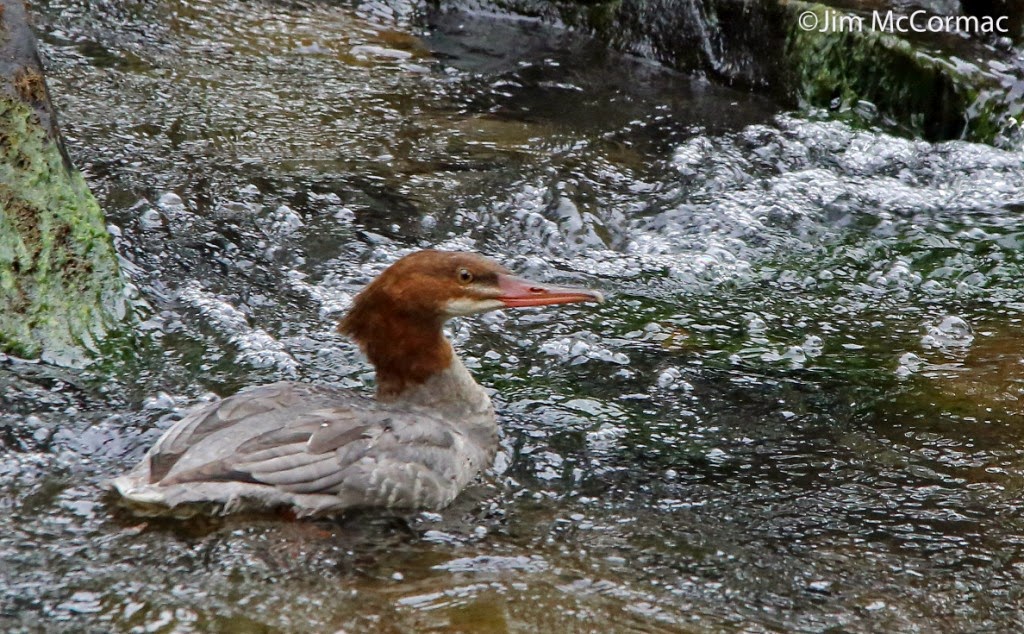A rocky mountain stream is punctuated by a quiet pool near Summersville, West Virginia. My friend Rachel Davis, who lives not far from here, showed me this little park back in late September. The place was full of biodiversity. Not long after exiting the car we saw a cool bird, and it was time to flip from the landscape lens to something with a bit more pulling power.
A hen Common Merganser! To birders used to seeing this species in migration and winter, when they frequent large lakes and rivers, seeing one on a small creek might seem strange. But Common Mergansers nest along streams, and I suspect that this bird was a local breeder who hadn't yet left the mountains.
Common Mergansers are BIG ducks - a hefty one can weigh 3.5 lbs. - but in spite of their bulk, they nest in cavities. I wrote about Ohio's only significant breeding population RIGHT HERE.
They're also fish eaters, and finicky about the water quality of the streams that they nest along. Cut the buffering forests and fill the stream with sediment, and the mergansers vanish. Otherwise pollute their streams and damage the aquatic food chain, and it's curtains for the fish ducks. Common Mergansers make a good barometer of the health of the streams, rivers, and lakes where they breed.
I was surprised to see this merganser where it was, as I didn't know that they bred in the area. But to see one of these ducks on such a small stream, even this late in the season, might be an indicator of local nesting.
Here's a map depicting the North America distribution of Common Merganser. As is evident, they breed in a broad northerly swath, and northern Ohio is at the southernmost latitude for eastern nesters. West Virginia isn't even shown in the breeding range.
The map needs updated, but it would have been accurate not so long ago. During the first West Virginia Breeding Bird Atlas, which took place from 1984 to 1989, no evidence of nesting Common Mergansers was found in the Mountaineer State. Fast forward to Atlas II, which began in 2009 and concluded at the end of this year's field season. The merganser's status had changed dramatically, and for the better. The ducks were found in 68 blocks, mostly in the eastern half of the state, and nesting was confirmed in 35 of them. A positive environmental story in an age of all too common gloom and doom.
Common Mergansers undoubtedly bred historically in much of West Virginia. Rampant logging and the attendant degradation of streams probably pushed them out for decades, just as it did here in Ohio. As forests have recovered and the aquatic health of forest streams improved, the ducks have made a comeback.
A hen Common Merganser! To birders used to seeing this species in migration and winter, when they frequent large lakes and rivers, seeing one on a small creek might seem strange. But Common Mergansers nest along streams, and I suspect that this bird was a local breeder who hadn't yet left the mountains.
Common Mergansers are BIG ducks - a hefty one can weigh 3.5 lbs. - but in spite of their bulk, they nest in cavities. I wrote about Ohio's only significant breeding population RIGHT HERE.
They're also fish eaters, and finicky about the water quality of the streams that they nest along. Cut the buffering forests and fill the stream with sediment, and the mergansers vanish. Otherwise pollute their streams and damage the aquatic food chain, and it's curtains for the fish ducks. Common Mergansers make a good barometer of the health of the streams, rivers, and lakes where they breed.
I was surprised to see this merganser where it was, as I didn't know that they bred in the area. But to see one of these ducks on such a small stream, even this late in the season, might be an indicator of local nesting.
Map courtesy of Birds of North America Online
Here's a map depicting the North America distribution of Common Merganser. As is evident, they breed in a broad northerly swath, and northern Ohio is at the southernmost latitude for eastern nesters. West Virginia isn't even shown in the breeding range.
The map needs updated, but it would have been accurate not so long ago. During the first West Virginia Breeding Bird Atlas, which took place from 1984 to 1989, no evidence of nesting Common Mergansers was found in the Mountaineer State. Fast forward to Atlas II, which began in 2009 and concluded at the end of this year's field season. The merganser's status had changed dramatically, and for the better. The ducks were found in 68 blocks, mostly in the eastern half of the state, and nesting was confirmed in 35 of them. A positive environmental story in an age of all too common gloom and doom.
Common Mergansers undoubtedly bred historically in much of West Virginia. Rampant logging and the attendant degradation of streams probably pushed them out for decades, just as it did here in Ohio. As forests have recovered and the aquatic health of forest streams improved, the ducks have made a comeback.
.jpg)
.jpg)
.jpg)
